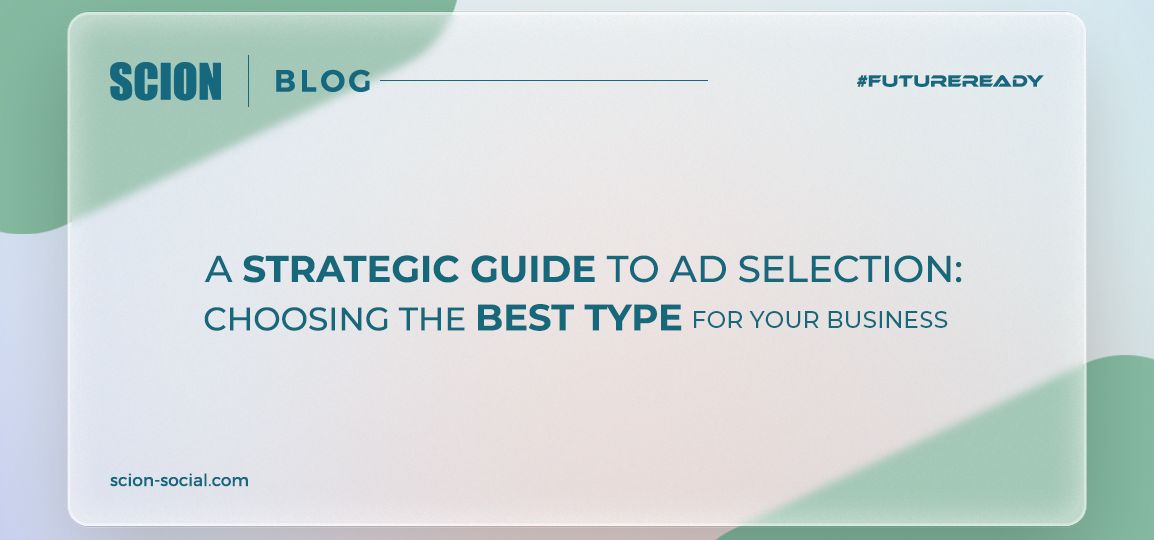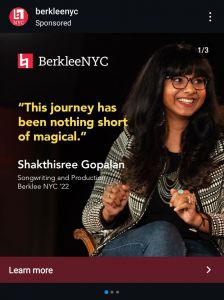
A Strategic Guide to Ad Selection: Choosing the Best Type for Your Business
What is Digital Advertising?
Digital advertising is like having a personal assistant that knows exactly what people want and shows it to them right when they need it.
Ever crave a cheesecake so badly you Google “best cheesecake near me”? Instantly, a list of options pops up, leading you straight to your perfect slice. That’s digital advertising in action.
Unlike traditional billboards or TV commercials, digital advertising is way more flexible and targeted. You can show your ads to exactly the right people at the right time. And the best part? You can track how well your ads are doing, so you know what’s working and what’s not.
How will Digital Advertising Help Your Business?
- Increased Visibility: Digital ads can help your brand reach a wider audience and increase brand awareness.
- Targeted Reach: With the ability to target specific demographics, interests, and behaviors, you can reach the most relevant audience for your business.
- Measurable Results: Digital advertising provides detailed analytics, allowing you to track the performance of your campaigns and make data-driven decisions.
- Cost-Effective: Compared to traditional advertising, digital ads can be more cost-effective, especially when targeting specific audiences.
What are the three main Digital Ads Pricing models?
- Cost Per Click (CPC): You pay each time someone clicks on your ad.
- Cost Per Mille (CPM): You pay for every 1,000 impressions (times your ad is seen).
- Cost Per Action (CPA): You pay only when someone takes a specific action, like making a purchase or signing up for a newsletter.
Not sure which type of ad is right for you? Don’t worry, we’ve got you covered. Let’s dive in and find the perfect match for your business!
Types of Digital Advertising
You’re scrolling through your phone, mindlessly swiping through your social media feed. Suddenly, a captivating video pops up, showcasing a new product you’ve never seen before. Or perhaps you’re searching for a local restaurant and a sponsored ad for a nearby eatery appears at the top of your search results.
These are just a few examples of the many types of advertisements that we encounter daily. Let’s look at the different types of ads and how they work.
Search Engine Ads
Search Ads
These ads appear at the top or bottom of search engine results pages, directly related to the user’s search query with specific keywords.
What they’re used for:
- Capturing the attention of users actively seeking products or services.
- Driving immediate traffic to your website.
How they’re used:
- Ads appear at the top or bottom of search engine results pages.
- They are triggered by relevant keywords searched by users.
- Businesses bid on keywords to determine their ad’s position.
Best for:
- Any business looking to generate leads and sales quickly.
- Businesses with specific target audiences.
- E-commerce businesses.
For instance, a plumbing company can target keywords like “plumber near me” or “plumbing services”
Display Ads
These ads are typically displayed on websites and apps in various formats, including banners, images, and videos.
What they’re used for:
- Building brand awareness.
- Reaching a broader audience.
- Promoting specific products or offers.
How they’re used:
- Ads are displayed on websites and apps in various formats (banners, images, videos).
- They can be targeted based on interests, demographics, and behaviors.
- Businesses can choose from different ad formats and placements.
Best for:
- Any business looking to increase brand visibility.
- Businesses with a strong visual identity.
- Businesses targeting specific demographics or interests.
A brand can use display ads to showcase their latest drop or launch on lifestyle websites.
Shopping Ads
Also called Product Listing Ads (PLAs), these ads feature products with images, prices, and descriptions.
What they’re used for:
- Showcasing products directly to potential customers.
- Driving traffic to your online store.
- Increasing sales.
How they’re used:
- Ads feature product images, prices, and descriptions.
- They appear on search engine results pages and Google Shopping.
- Businesses create product feeds to populate their shopping ads.
Best for:
- E-commerce businesses.
- Retailers with a wide product range.
- Businesses selling tangible products.
An online retailer can use shopping ads to highlight their best-selling items and drive traffic to their website.
Local Search Ads
These ads appear on Google Maps and search results for local searches.
What they’re used for:
- Attracting customers in your immediate vicinity.
- Promoting your physical location.
- Generating local leads.
How they’re used:
- Ads appear on Google Maps and search results for local searches.
- They are triggered by location-based search queries.
- Businesses can add information about their location, hours, and services.
Best for:
- Businesses with physical locations.
- Local services (restaurants, salons, etc.).
- Businesses targeting customers within a specific geographic area.
A local restaurant can use local search ads to promote their specials or highlight their location on Google Maps.
Dynamic Search Ads (DSAs)
These ads are automatically generated based on your website’s content. They are useful for businesses with frequently changing inventory or offers.
What they’re used for:
- Promoting products or services based on your website’s content.
- Automatically adapting to your changing inventory or offers.
- Reaching a wider range of potential customers.
How they work:
- Search engine crawls website content.
- User searches on the search engine.
- Search engine matches the query to a page on the site.
- DSAs are automatically created with tailored ad copy.
Best for:
- Businesses with frequently changing inventory or offers.
- Businesses with well-developed websites.
- Businesses looking to expand their reach.
A travel agency can use dynamic search ads to promote last-minute deals or seasonal packages.
Social Media Ads
Sponsored Posts
These paid ads appear in users’ feeds on social media platforms.
What they’re used for:
- To increase brand awareness
- Drive website traffic
- Generate leads, and boost sales.
How they work:
- Businesses pay to have their ads appear in users’ feeds on platforms like Facebook, Instagram, and Twitter.
- They can target specific demographics, interests, and behaviors to reach their ideal audience.
Best for:
- Businesses looking to engage with their target audience and achieve specific marketing goals.
- Small startups or established brands
Brands use these ads to ger more reach on social media platforms. In this case, using a giveaway to get more followers and engagement.
Story Posts
These ads appear in users’ Stories on platforms like Instagram and Snapchat. They are great for businesses that want to reach a younger audience and create a more immersive experience.
What they’re used for:
- To reach a younger audience.
- Create a more immersive experience.
- Encourage quick engagement.
How they work:
- These ads appear in users’ Stories, often disappearing after 24 hours.
- They can be images, videos, or polls.
Best for:
- Businesses targeting younger demographics or promoting time-sensitive offers.
Influencer Marketing
This involves partnering with influencers to promote your products or services. It is a powerful way to reach a targeted audience and build trust. A fitness brand can collaborate with fitness influencers to showcase their products and inspire their followers.
Nike made a significant mark using influencer marketing when they signed Michael Jordan. The brand became the 3rd largest shoe manufacturer in 1984 and consecutively launched the well-known Air Jordans which are still one of the biggest examples of cultural influences to date.
Static Image Ads
These simple ads feature a single image as an effective way to showcase products or services. They are a classic option for businesses of all sizes.
How it works:
These ads feature a single image, often with a headline and a call to action.
Best for:
Businesses with products or services with a clear message.
Carousel Ads
These ads allow you to showcase multiple images or videos in a single ad. They are ideal for showcasing multiple products or telling a story.
How they work:
These ads allow users to swipe through multiple images or videos.
Best for:
Businesses with a variety of products or services to promote, or those looking to create a more engaging ad experience.
Video Ads
Video ads are a great way to showcase products or services to capture the audience’s attention in a visually engaging way. A gaming company can use video ads to showcase gameplay footage and attract new players.
Why Video ads are super effective:
- The ads showcase people capturing extraordinary moments making the product feel accessible and relatable to a wide audience.
- The videos are beautifully shot and edited, highlighting the product’s capabilities in a visually stunning way.
- They evoke strong emotions, such as joy, wonder, and nostalgia, creating a lasting impression on viewers.
- These ads have often gone viral on social media, generating massive reach and brand awareness.
Best for:
Businesses with products or services that can be effectively demonstrated through video, such as tutorials, product demos, or storytelling.
Apple has featured celebrities like Ansel Elgort and Billie Eilish in some of the “Shot on iPhone” ads, further enhancing their impact.
Content and Native Ads
Content and native ads are forms of advertising that aim to blend seamlessly into the content of a platform, rather than appearing as traditional advertisements. They are designed to be less intrusive and more engaging to the audience.
Sponsored Content
Sponsored content is paid content that appears on a publisher’s website or blog. These ads are also known as PPC (Pay-per-click) ads. It is a subtle way to promote your brand and reach a targeted audience. Sponsored ads are a great way to get readers who are already interested in a topic related to your brand, so it is a smart way to get them to check out what you have to offer.
Here’s an example:
Sponsored ads may look like display ads, but the key distinctions are:
Sponsored Ads: Keyword-based, search results, bid-based.
Display Ads: Placement-based, websites/apps, impression-based.
Branded Content
Brands create content to promote their products or services. This is a more creative and engaging approach to advertising where a brand aims to build a relationship with the audience and position the brand as a valuable resource instead of directly selling a product.
The goal of branded content is to be informative, entertaining, and relevant to the target audience, ultimately leading to increased brand awareness, trust, and loyalty.
Netflix’s popular series “Stranger Things” merchandise is a popular example of branded content ads. While the show itself is the primary product, Netflix has created a vast array of merchandise, including clothing, toys, and collectibles, that are inspired by the series.
Newsletter
Email marketing campaigns are sent directly to subscribers. They are a powerful tool for building and maintaining relationships with customers. Newsletters provide a direct channel of communication, allowing businesses to share updates, offer exclusive deals, and provide valuable content.
Key benefits:
- Newsletters allow businesses to stay connected with customers regularly, fostering loyalty and trust.
- They can be used to collect email addresses from potential customers and nurture them into leads.
- They’re great for sales promotion and special offers.
- Businesses can also share informative and engaging content, such as blog posts, articles, and videos.
Content Syndication
This involves distributing your content on other websites or platforms. It is a way to increase your reach and visibility.
Key benefits:
- Improved SEO: Syndicated content can help improve your website’s search engine ranking.
- Brand Exposure: Syndication can help increase your brand’s visibility and awareness.
- Backlinks: Syndicated content can provide valuable backlinks to your website, which can further improve your SEO.
A popular blog might syndicate its articles on other relevant websites, such as industry publications or social media platforms. This can help the blog reach a wider audience and establish itself as a thought leader in its field.
Mobile Ads
Mobile ads have become a cornerstone of digital marketing as the world increasingly relies on smartphones and tablets. These ads are specifically designed to be effective on smaller screens, offering businesses unique opportunities to reach a highly engaged audience.
In-App Ads
In-app ads appear within mobile apps. These ads can be as unobtrusive as a banner at the bottom of a screen or as immersive as a full-screen ad that interrupts app usage.
Here’s an example:
These ads can be tailored to specific user profiles, considering factors like app usage, interests, and demographics. This ensures your message reaches the people most likely to be interested in your brand.
SMS Marketing
These text message marketing campaigns are a direct and personal way to reach customers.
How they work:
Businesses collect customer phone numbers and send targeted text messages with promotions, reminders, or updates.
Best for:
Restaurants, retail stores, service providers, and any business with a customer database.
Other Ads
Affiliate Marketing
This involves partnering with other websites or influencers to promote your products or services. It is a performance-based advertising model.
A fitness equipment retailer can partner with fitness bloggers to promote their products.
Retargeting Ads
These ads show up to people who have visited your website but have not made a purchase or an interaction. They are a way to remind potential customers about your products or services.
An e-commerce website can use retargeting ads to encourage abandoned cart customers to complete their purchase.
AR/VR Ads
These ads use augmented or virtual reality technology. They are a cutting-edge way to create immersive and interactive experiences.
A furniture retailer can use AR/VR ads to allow customers to visualize their products in their own homes.
How to determine the best advertising type for your business?
Now that you have a solid grasp of the various ad types, it’s essential to select the most suitable one for effective advertising. Here’s a breakdown of how to choose the best option:
Define Your Goals
- Brand Awareness: If you want to introduce your brand to a wider audience, consider display ads or social media advertising.
- Lead Generation: For collecting contact information from potential customers, opt for search engine marketing (SEM) or content marketing.
- Sales: To drive direct sales, focus on SEM, social media advertising, or email marketing.
- Engagement: For building relationships with customers, consider social media advertising, content marketing, or email marketing.
Identify Your Target Audience
- Demographics: Age, gender, location, income, etc.
- Interests: Hobbies, passions, online behaviors.
- Psychographics: Lifestyle, values, attitudes.
- Behavior: Previous purchases, browsing history.
Consider Your Budget
- Set a realistic budget: Allocate funds based on your goals and target audience.
- Evaluate costs: Compare the costs of different ad types and platforms.
- Consider ROI: Calculate the return on investment (ROI) for each ad type.
Experiment and Measure
- Test different ad types: Try various options to see what works best.
- Track performance: Monitor key metrics like clicks, impressions, conversions, and ROI.
- Make adjustments: Based on your findings, refine your ad strategy.
So, there you have it – a quick rundown of the different types of ads out there. Figuring out which one is best for your business is all about knowing your audience and your goals.
Stay tuned for the latest digital marketing insights. Whatever your advertising needs, we’ve got you covered!
FAQ’s
Track key metrics such as revenue, cost, and profit to calculate ROI. This will help you determine the effectiveness of your advertising efforts.
A combination of ad types can often be more effective than relying solely on one. Experiment with different formats to see what works best for your business.
Keep up with industry news, attend conferences, and follow marketing influencers to stay informed about the latest developments in advertising.
Mobile ads offer a targeted way to reach a large and engaged audience. They are particularly effective for businesses that want to target specific demographics or locations.
No, there is no one-size-fits-all “best” ad type. The ideal ad format depends on your specific circumstances and objectives.
















